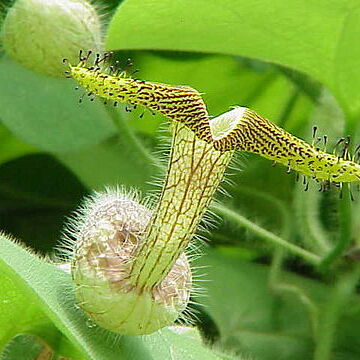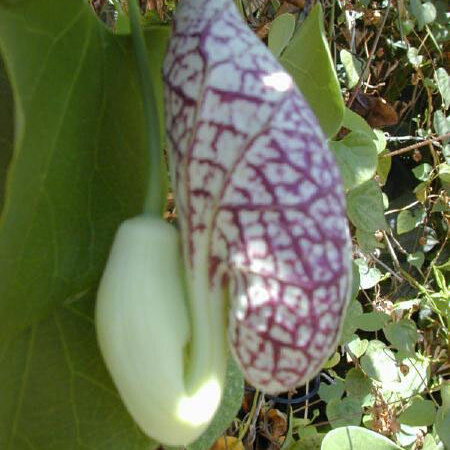Herbs, shrubs, rarely lianas, subshrubs, or trees; root, stems, and leaves with oil cells. Leaves alternate; stipules absent; petiole usually present and well defined; leaf blade simple, usually pinnately veined, sometimes palmately 3-5-veined, margin usually entire, rarely 3-5-lobed. Inflorescences terminal or axillary, racemes, cymes, or corymbs, or flowers solitary. Flowers bisexual, zygomorphic or actinomorphic. Perianth usually with 1 petaloid whorl (in Saruma with 2 whorls: outer one sepaloid, inner one petaloid), mostly connate into distinct tube, cylindric to campanulate or subglobose; limb rotate, urceolate, cylindric, or ligulate, 1-3-lobed; lobes valvate. Stamens 6-12 (in China), in 1 or 2 series; filaments adnate to ovary (in Asarum) or style column (in Thottea) with anthers free, or filaments and anthers fully adnate to style column to form gynostemium (in Aristolochia); anthers 2-loculed, dehiscence longitudinal. Ovary inferior to superior, 6-loculed (in Thottea 4-loculed); carpels connate only at base or fully fused; ovules numerous, anatropous, usually in 1 or 2 series; placentation parietal. Styles free or connate, column 3-or 6-lobed (in Thottea 5-20-lobed). Fruit a fleshy or dry capsule, rarely siliquiform or follicular. Seeds many; testa somewhat hard or crustaceous; endosperm copious, fleshy; embryo minute.
Vines or less often perennial herbs or small to large erect shrubs. Stems of woody species showing broad medullary rays. Leaves spirally arranged, simple, entire or lobed, petiolate; true stipules absent. Inflorescence axillary or cauline, racemose or cymose, or flowers solitary or clustered, with or without bracts. Flowers bisexual, zygomorphic or rarely actinomorphic, usually fetid. Calyx gamosepalous, petaloid, tubular at least below, 1–3-lobed or lobeless. Petals absent (in Australia), much reduced or well developed. Stamens 6–24 in 1 or 2 series around apex of ovary or stylar column; filaments thick, short, free or scarcely distinguishable from column; anthers free or adnate with 2 parallel loculi, extrorse, opening longitudinally. Ovary inferior or rarely semi-superior, 4–6-locular or imperfectly locular; styles thick, short, united into a column, divided into 3–many stigmatic lobes; ovules numerous per cell. Fruit usually capsular or rarely indehiscent. Seeds numerous, often immersed in pulpy endocarp; raphe sometimes thickened or winged; endosperm copious, fleshy; embryo small.
Herbs or lianas [shrubs, rarely trees], deciduous or evergreen, often aromatic. Wood with broad medullary rays. Leaves alternate, simple, petiolate. Leaf blade unlobed, margins entire. Inflorescences terminal or axillary, racemes or solitary flowers, rarely fan-shaped cymes. Flowers bisexual; calyx enlarged, petaloid, usually tubular, [1-,] 3-, [6-, rarely 5-]merous, lobes valvate; corolla usually reduced to scales or absent; stamens 5, 6, or 12 [multiples of 3 or 5], free or adnate to styles and stigmas, forming gynostemium; anthers extrorse; pistil 1, 4-6-carpellate; ovary inferior, partly inferior, or superior; placentation axile (and ovaries 4-6-locular) or parietal; ovules many per locule, anatropous. Fruits capsules [follicles], regularly to irregularly loculicidal, rarely indehiscent [septicidal]. Seeds often flattened; endosperm copious.
Ovary inferior, rarely half inferior, 4–6 locular, syncarpous or apocarpous in Saruma, placentas parietal or seemingly axile; ovules numerous, anatropous, in 1–2 vertical series in each locule, horizontal or pendulous; styles connate into a column; stigma 3–many-lobed
Stamens 6-∞ , in 1–2 series around the apex of the ovary or stylar column; filaments short, thick, free or scarcely distinguishable from the column; anthers free or adnate, with 2 parallel cells, extrorse, opening longitudinally
Flowers terminal, axillary or borne on the stem (cauligerous), solitary, fasciculate or in few to many-flowered racemose or cymose inflorescences, hermaphrodite, epigynous, actinomorphic or zygomorphic, with or without bracts
Perianth single, often enlarged and petaloid, variously produced above the ovary, often tubular, the limb either symmetrically 3-lobed, or unilateral and entire or lobed, usually highly coloured and foetid
Ovary inferior or rarely semi-superior, 4–6-celled or imperfectly celled; styles thick, short, united into a column, divided into 3–8 stigmatic lobes; ovules numerous in each cell
Stamens 6–many in 1–2 or more whorls, free or adnate to the stylar column forming agynostemium; anthers 2-thecous with 4 pollen sacs, extrorse, dehiscing longitudinally
Seeds numerous, often immersed in the pulpy endocarp, 3-sided or flattened, raphe sometimes thickened or winged; endosperm copious, fleshy; embryo small
Calyx petaloid, usually enlarged, basally tubular, expanding into a limb above; limb symmetrically 3-lobed, or unilateral and entire or lobed
Climbing shrubs, or rarely dwarf and erect; stems of the woody species in cross-section showing broad medullary rays; roots often medicinal
Flowers solitary or racemose, axillary or in clusters on the older wood, pedicellate, hermaphrodite, zygomorphic or rarely actinomorphic
Fruit capsular or rarely indehiscent, sometimes dehiscing from the base upwards and hanging like an inverted parachute
Seeds usually many, variously shaped, raphe sometimes thickened and winged; endosperm abundant, embryo minute
Perennial herbs or shrubs, erect, scrambling or climbing, sometimes lianes, often with tuberous rhizomes
Fruit a capsule, dehiscing septicidally or irregularly, or more rarely indehiscent
Leaves alternate, petiolate, exstipulate, simple, entire, sometimes lobed
Leaves petiolate, alternate, exstipulate, simple, mostly entire
Petals absent except in Saruma, vestigial in Asarum


